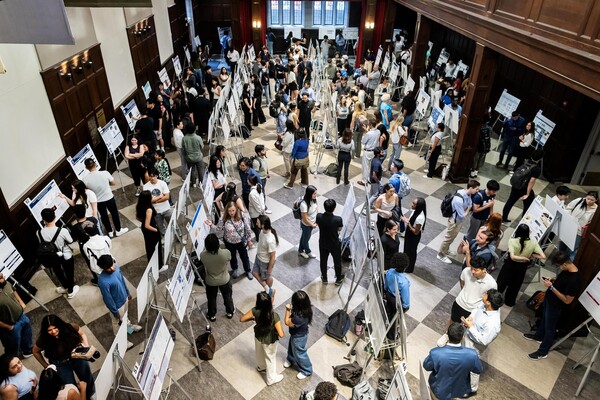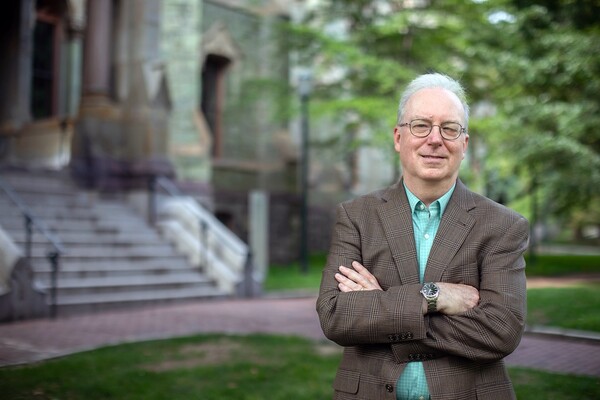
Image: Mininyx Doodle via Getty Images

In his new book, “Making Sense of a United Ireland,” political scientist Brendan O’Leary of the School of Arts & Sciences explores the contentious issue of a reunited Ireland. O’Leary, a global expert on divided places who has been profoundly engaged with the Irish question for nearly four decades, argues that the time to consider the future of the island is now.
The following is an excerpt from “Making Sense of a United Ireland: Should it Happen? How Might it Happen?,” published by Penguin, Sandycove. Copyright ©2022. All rights reserved.
“Six into 26 won’t go!” I saw that painted on a Belfast gable wall when I was a boy. Being a competitive little lad, I thought the graffiti author didn’t understand fractions. After all, six goes into 26 “four and a third times.” Of course, the statement was not about division, where it may have been correct according to certain schoolteachers, but about partition.
The six counties of Northern Ireland could not, would not, and should not fit into the 26 counties of the Republic of Ireland. Monarchist, Protestant, English-speaking people could not live in the Republican, Catholic and Gaelic nation-state. The statement was a slogan—a word derived from the Irish for “war cry.” It proclaimed an “impossibility.”
Irish reunification was long deemed impossible. For many it still is, especially because of the long conflict—or war or “Troubles”—between 1966 and 2005, or 1968 and 1998. The dates and names are contested. Yet reunification is now certainly possible, indeed highly probable, though not inevitable—at least, not yet.
But even those who want it to happen are not prepared—at least not adequately prepared, even if they may think otherwise. That includes political parties like Fianna Fáil, Fine Gael, Sinn Féin, the SDLP, the Irish Labour Party, the Greens, People Before Profit, and others.
The Government of Ireland Act of 1920, the instrument of partition enacted by the Westminster parliament, was the most enduring gerrymander of the last century. With some truculence, Ulster unionists accepted a six-county Northern Ireland rather than one consisting of all nine counties of Ulster. Their local leaders had made a strategic decision. In the words of James Craig, Northern Ireland’s first prime minister, they would secure those counties they could control, and thereby create “a new and impregnable Pale,” behind which loyalists could withdraw and regroup to maintain the union with Great Britain.
That control has now been lost, however. The ramparts of the new Pale are long gone. Unionist control went in 1972 when the London government shut down the Northern Ireland parliament, which the Ulster Unionist Party (UUP) had dominated for 50 years. The ramparts were the Royal Ulster Constabulary (RUC), the armed police force, and the B Specials, its armed reserve. The former was mostly Protestant; the latter, originally recruited from the Ulster Volunteer Force (UVF), entirely Protestant.
The most famous Ulster unionist slogan is “no surrender,” still cried at the annual August and December parades of the Apprentice Boys over Derry’s walls—or Londonderry’s. The “boys” are nowadays mostly somewhat-matured men. The slogan means no surrender either to Irish Catholics or to illegitimate British power.
There have, however, been several unionist surrenders—as well as British betrayals. Ulster unionists parted with their southern counterparts, who wanted all of Ireland to remain in the United Kingdom, or in the British empire or in the British Commonwealth. Southern unionists would have settled for “dominion status” for the entire island in 1917–18 so that they would have been part of a larger minority rather than the small one they became. They feared an Irish Republic, but they did not want partition. Ulster unionists preferred to leave southern unionists behind rather than bolster them in a sovereign united Ireland. As retreating generals do, they cut their losses.
Ulster unionists had made a solemn covenant on “Ulster Day” in September 1912. In it they pledged loyalty to their brothers and sisters throughout Ulster. The covenant was signed by more than 235,000 men, with a matching declaration signed by nearly the same number of women. The three counties of Donegal, Cavan and Monaghan, however, had large Catholic and nationalist majorities. A nine-county Ulster would have meant, according to the census of 1911, a Protestant-to-Catholic ratio of 57 to 43 rather than the 66-to-34 ratio of what became Northern Ireland.
The UUP leadership’s “inner circle” effectively surrendered the unionists of Donegal, Cavan and Monaghan to what became the Irish Free State. They might have had all of Ulster, and kept to their covenant, but then their demographic and electoral majority would have been highly unstable, and quickly reversible.
The British coalition government of 1918–22, made up of Conservative unionists and Liberal imperialists, and led by David Lloyd George, organized Ulster’s “downsizing.” The Ulster unionist elite were effectively allowed to pick their preferred Northern Ireland: six counties, four with cultural Protestant and unionist majorities—Antrim, Down, Armagh and Londonderry—and two without—Fermanagh and Tyrone. Unofficially, unionists would call these six counties Ulster. Officially UK governments refused requests to rename Northern Ireland as Ulster, but they had no objections to the naming of the Royal Ulster Constabulary, or later to the Ulster Defence Regiment, or to “the Ulster Banner”.
Unionist-dominated Ulster is now over. A referendum in the North on Irish unity is likely at the end of this decade, to be followed by one in the South if the rules of the Belfast Agreement of 1998 are followed. That is because Northern Ireland’s tectonic plates have shifted. Its cultural Catholic population—those who are Catholic or come from a predominantly Catholic family formation—now outnumber cultural Protestants.
Since the last quarter of the 19th century such Catholics have mostly voted for nationalist parties with platforms that favor an autonomous or independent and united Ireland. Today the largest of these parties are Sinn Féin and the Social Democratic and Labour Party (SDLP). Not everyone who votes Sinn Féin or SDLP will vote for Irish reunification if and when the Northern referendum happens. Like everyone with a vote they will want to know what is on offer and what the benefits and costs are, both for themselves and their families and for their peoples. But cultural Catholics will have a choice, and their votes will matter—with increasingly decisive importance over the rest of this decade. By 2030, as I shall try to show, the decision will be theirs to make.
Brendan O’Leary is the Lauder Professor of Political Science in the School of Arts & Sciences at the University of Pennsylvania. The text above was excerpted from his book “Making Sense of a United Ireland” Copyright ©2022 Penguin, Sandycove. Used by arrangement with the publisher.
Kristen de Groot

Image: Mininyx Doodle via Getty Images

nocred

Image: Pencho Chukov via Getty Images

Charles Kane, Christopher H. Browne Distinguished Professor of Physics at Penn’s School of Arts & Sciences.
(Image: Brooke Sietinsons)